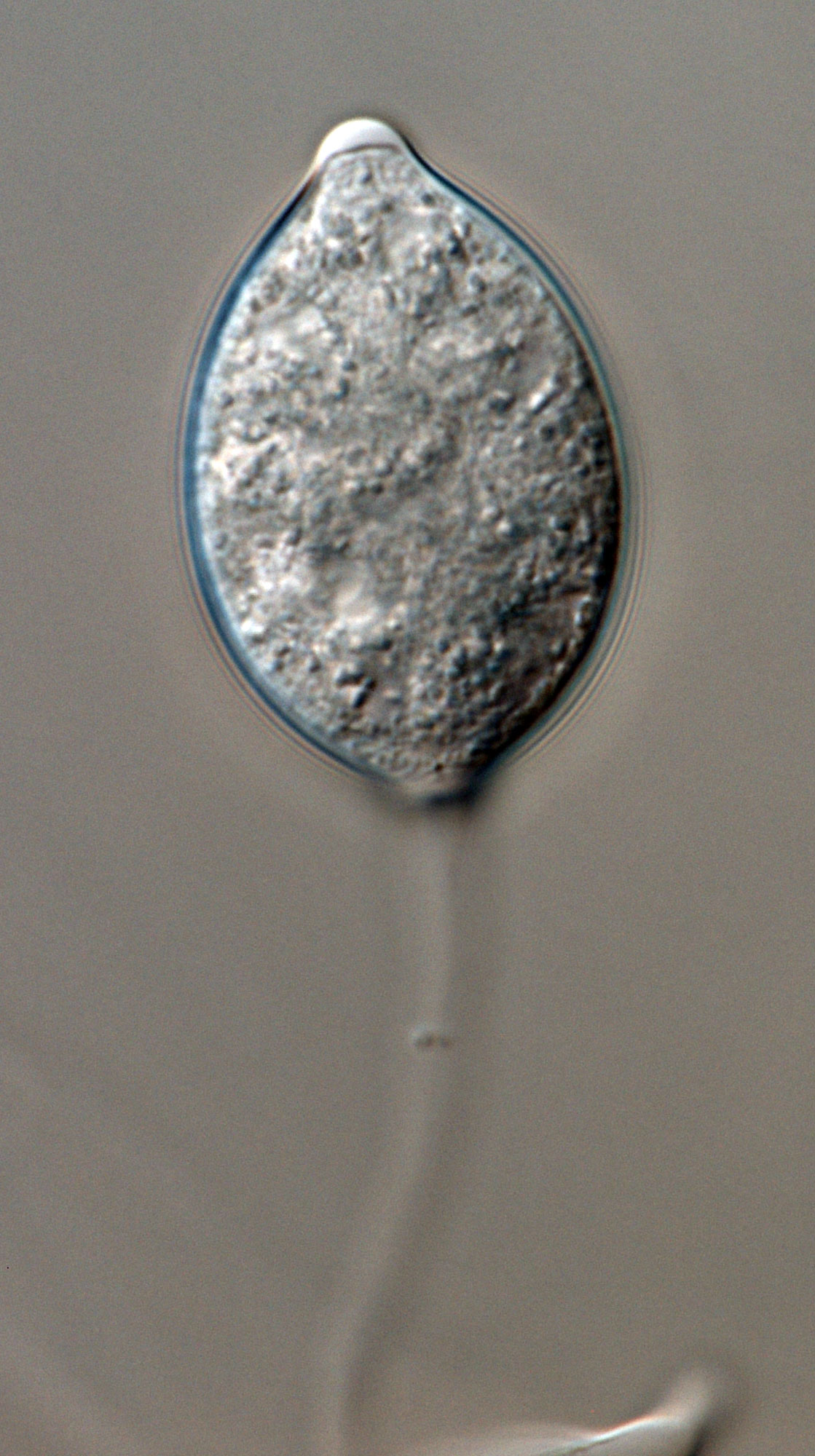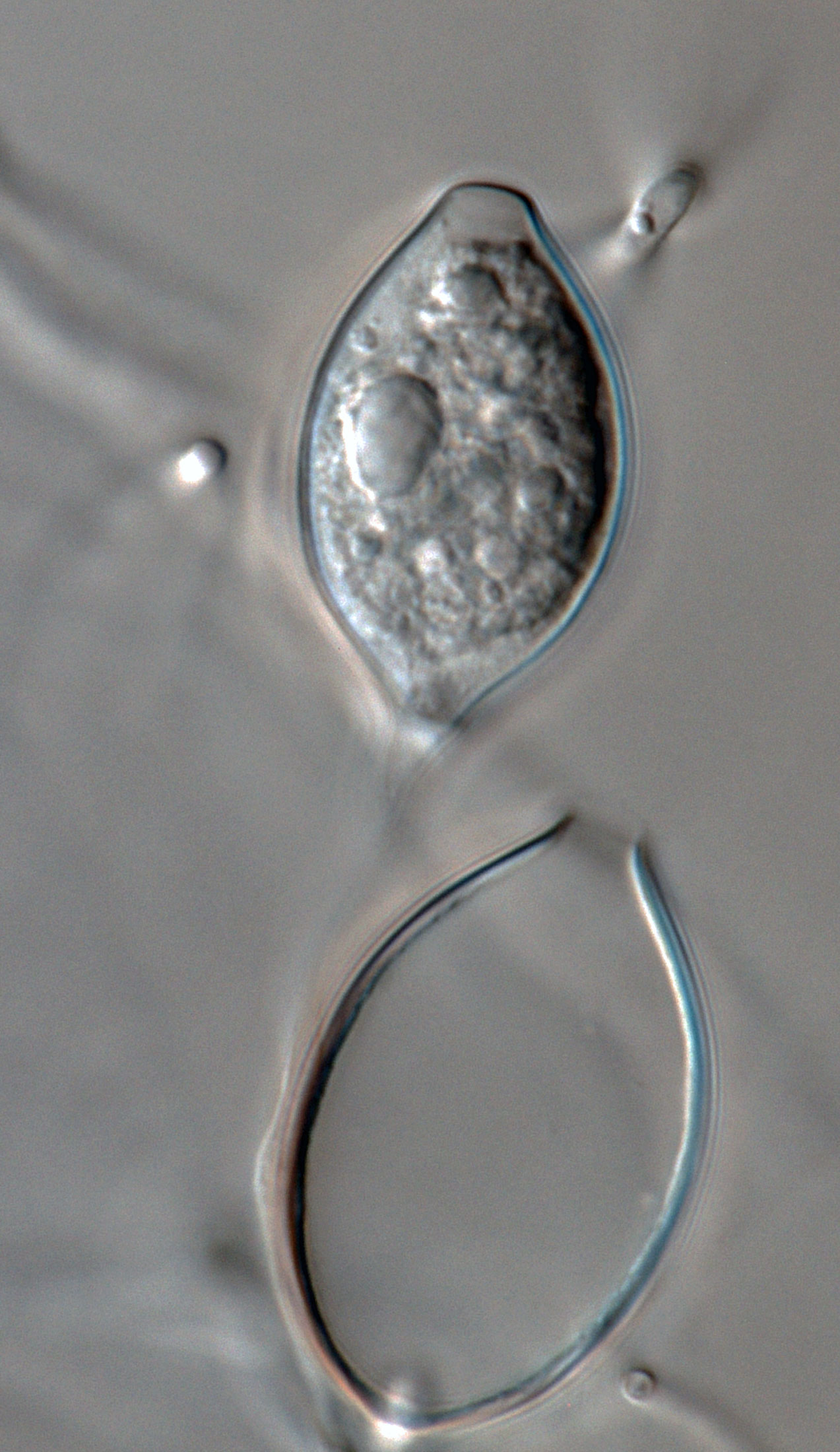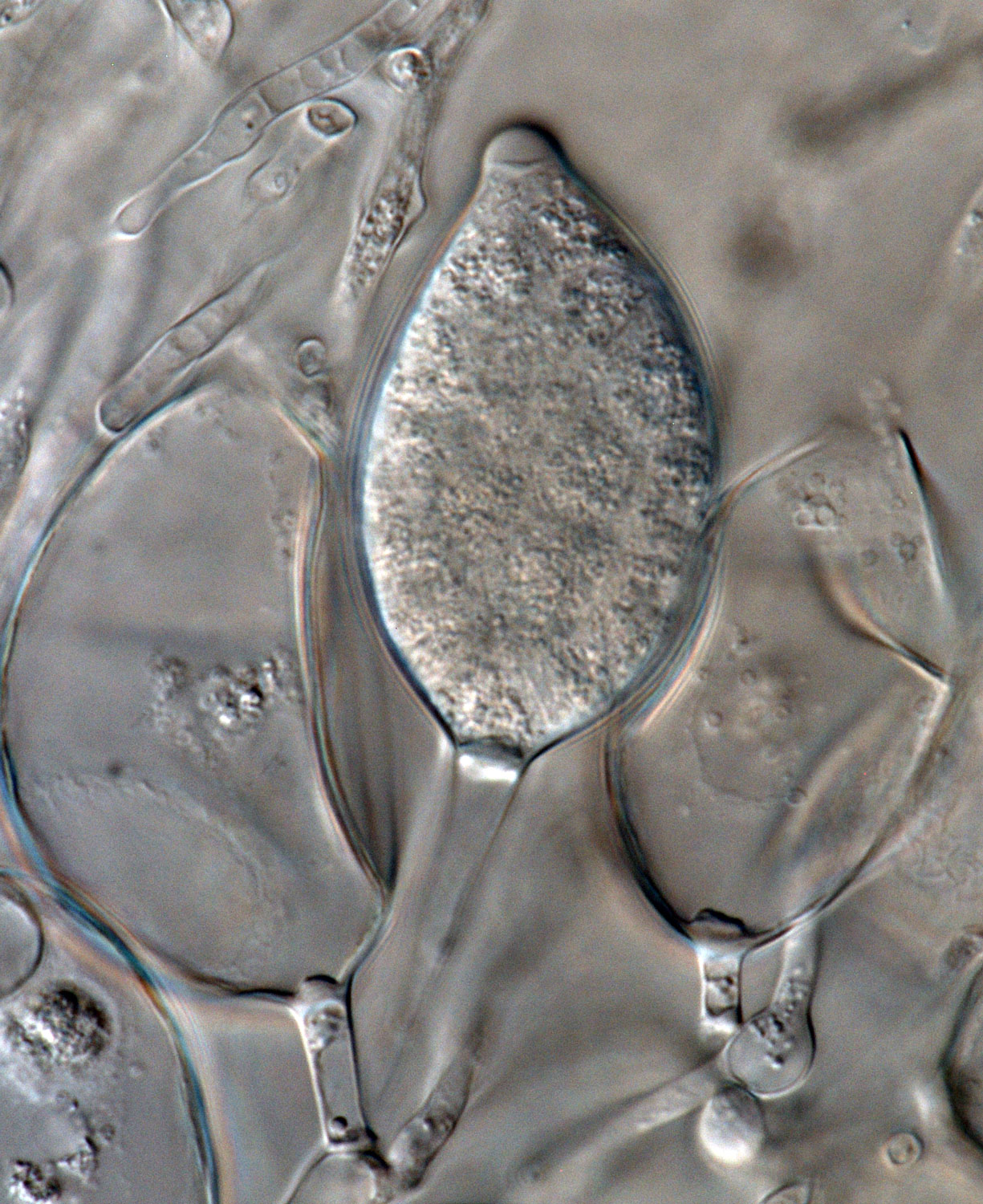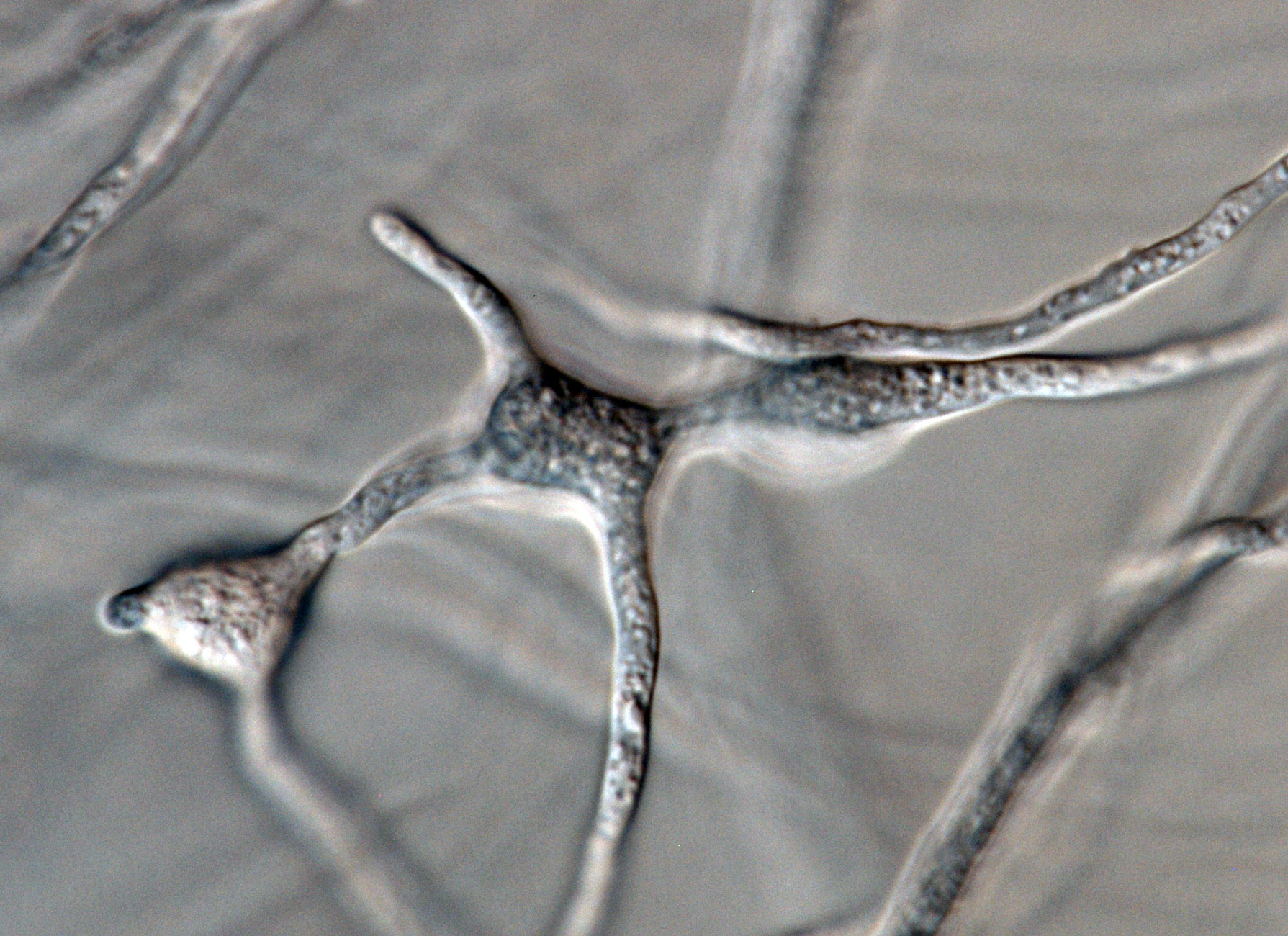Phytophthora meadii (in progress - Abad et al. 2023b)
|
Phytophthora spp. in subclade 2a: portion of the seven-loci ML phylogeny featuring the type cultures of 212 described species (by T. Bourret). Notice the position of P. meadii selected specimen CBS 148927 = S&T BL 81. Gloria Abad, USDA S&T.
|
|
Phytophthora spp. in subclade 2a: Morphological Tabular key (PDF) and Tabular key legends (PDF) in IDphy2 KEY SECTION. Notice the data of P. meadii selected specimen CBS 148927 = S&T BL 81. Gloria Abad, USDA S&T.
|
|
Phytophthora meadii (CPHST BL 81) colonies of the selected specimen grown for 7 days on (a) V8® Agar, (b) potato dextrose agar, and (c) malt extract agar; photo by Clinton Greub, Krysta Jennings, and Leandra Knight, USDA-APHIS-PPQ |
|
Phytophthora meadii (CPHST BL 120) colonies of a selected specimen grown for 7 days on (a) V8® Agar, (b) potato dextrose agar, and (c) malt extract agar; photo by Clinton Greub, Krysta Jennings, and Leandra Knight, USDA-APHIS-PPQ |
|
Phytophthora meadii (CPHST BL 82) colonies of a selected specimen grown for 7 days on (a) V8® Agar, (b) potato dextrose agar, and (c) malt extract agar; photo by Krysta Jennings and Leandra Knight, USDA-APHIS-PPQ |
|
Phytophthora meadii (CPHST BL 81, selected specimen) asexual phase: (a–d) sporangia papillated and semipapillated, (e) hyphal swellings; photos by Gloria Abad, USDA-APHIS-PPQ. |
|
Phytophthora meadii (CPHST BL 81, selected specimen) asexual phase: papillated sporangium; photo by Gloria Abad, USDA-APHIS-PPQ. |
|
Phytophthora meadii (CPHST BL 81, selected specimen) asexual phase: semipapillated sporangia; photo by Gloria Abad, USDA-APHIS-PPQ. |
|
Phytophthora meadii (CPHST BL 81, selected specimen) asexual phase: papillated sporangium; photo by Gloria Abad, USDA-APHIS-PPQ. |
|
Phytophthora meadii (CPHST BL 81, selected specimen) asexual phase: papillated sporangium; photo by Gloria Abad, USDA-APHIS-PPQ. |
|
Phytophthora meadii (CPHST BL 81, selected specimen) asexual phase: hyphal swellings; photo by Gloria Abad, USDA-APHIS-PPQ. |
Name and publication
Phytophthora meadii McRae (1918)
McRae W. 1918. Phylophthora meadii n. sp. on Hevea brasiliensis. Mem. Dept. Agric. India Vol IX: 219–273.
Nomenclature
from McRae (1918)
Mycobank
Etymology
named after Mr. A. H. Mead who first brought the disease to notice
Typification
Type: INDIA, Travancore, Cochin, and Malabar (at the present Kerala - in the South West Region India) collected from Hevea brasiliensis, the Para rubber tree. The first culture of the species was made on August 5th, 1915.
Ex-type: LOST
Well-authenticated specimen(s) selected by Gloria Abad:
Selected specimen #1: isolate CPHST BL 81 (= P19007 WPC) from Hevea brasiliensis INDIA
Selected specimen #2: isolate CPHST BL 82 (= P19023 WPC) from Hevea brasiliensis INDIA
Selected specimen #3: isolate CPHST BL 120 (= P19041 WPC) from Hevea brasiliensis INDIA
Selected specimen in other collections
(SE) CBS 148927, NRRL 64146, WPC P19007, S&T BL 81 (Abad)
Molecular identification
Voucher sequences for barcoding genes (ITS rDNA and COI) of the selected specimen (see Molecular protocols page)
Phytophthora meadii isolate CPHST BL 81 (= P19007 WPC) = ITS rDNA MG865529 COI MH136924
Phytophthora meadii isolate CPHST BL 82 (= P19023 WPC) = ITS rDNA MG865531, COI MH136926
Phytophthora meadii isolate CPHST BL 120 (= P19041 WPC) = ITS rDNA MG865530, COI MH136925
Voucher sequences for Molecular Toolbox with seven genes (ITS, β-tub, COI, EF1α, HSP90, L10, and YPT1
(see Molecular protocols page) (In Progress)
Voucher sequences for Metabarcoding High-throughput Sequencing (HTS) Technologies [Molecular Operational Taxonomic Unit (MOTU)]
(see Molecular protocols page) (In Progress)
Sequences with multiple genes for selected specimen in other sources
- NCBI: Phytophthora meadii CPHST BL 81
- NCBI: Phytophthora meadii CPHST BL 82
- NCBI: Phytophthora meadii CPHST BL 120
- NCBI: Phytophthora meadii P19007 (deposited as Phytophthora sp.)
- EPPO-Q-bank: Phytophthora meadii
- BOLDSYSTEMS: Phytophthora meadii (barcoding COI & ITS)
NOTE: NCBI: Phytophthora meadii isolate 61J9 (ex-type): citation of this specimen as ex-type is incorrect. This corresponds to specimen Phytophthora meadii IMI 129185 CBS 219.88 from Hevea brasiliensis (cited in Kroon et al. 2004 and Cooke et al. 2000). This isolate was collected in India in 1998 and is a well-authenticated specimen for the species, but not the ex-type.
Position in multigenic phylogeny with 7 genes (ITS, β-tub, COI, EF1α, HSP90, L10, and YPT1)
Clade clade:
a taxonomic group of organisms classified together on the basis of homologous features traced to a common ancestor
2a
Morphological identification
Colonies and cardinal temperatures
Colony colony:
assemblage of hyphae which usually develops form a single source and grows in a coordinated way
morphology after 7 days of growth on potato dextrose agar and V8 agar with stellate pattern, on malt extract agar with light stellate pattern. Minimum temperature for growth is 6°C, optimum 25–30°C, and maximum 32°C.
Conditions for growth and sporulation
Phytophthora meadii produces abundant sporangiasporangia:
sac within which zoospores form, especially when water is cooled to about 10°C below ambient temperature; in solid substrates, sporangia usually germinate by germ tubes
and zoosporeszoospores:
motile spore that forms within the sporangium and exits through the exit pore and is capable of swimming for several hours; it has both a tinsel flagellum and a whip-like flagellum
in V8 agar flooded with 10% soil solution.
Asexual phase
SporangiaSporangia:
sac within which zoospores form, especially when water is cooled to about 10°C below ambient temperature; in solid substrates, sporangia usually germinate by germ tubes
papillatepapillate:
pertaining to the production of a distinct papilla at the distal end of the sporangium (cf. nonpapillate and semipapillate)
to semipapillatesemipapillate:
pertaining to the production of shallow having papilla that are not well developed, shallow and less nipple-like than fully papillate structures
, sometimes bipapillate; caducouscaducous:
pertaining to sporangia that become dislodged readily (i.e. deciduous) and separate from the sporangiophore (cf. persistent)
with medium to long pedicelpedicel:
the hyphal base of a sporangium that remains attached after the sporangium separates, or is shed, from the sporangiophore; the pedicel may be short (< 5 µm), medium (5–20 µm), or long (> 20 µm)
(10–20 μm long); ovoidovoid:
egg-shaped, with the widest part at the base of the sporangium and the narrow part at the apex
, ellipsoidellipsoid:
refers to a solid body that forms an ellipse in the longitudinal plane and a circle in cross section; many fungal spores are ellipsoidal or elliptic
, elongate, obpyriformobpyriform:
inversely pear-shaped, i.e. with the widest part at the point of attachment (cf. pyriform)
, globoseglobose:
having a rounded form resembling that of a sphere
, irregular forms (17–44 L x 15–29 W μm); originated in sympodial branched sporangiophores. Hyphal swellings small, globoseglobose:
having a rounded form resembling that of a sphere
to elongate, produced mostly in sporangiophores. ChlamydosporesChlamydospores:
an asexual spore with a thickened inner wall that is delimited from the mycelium by a septum; may be terminal or intercalary, and survives for long periods in soil
rarely produced.
Sexual phase
Heterothallic/homothallic. OogoniaOogonia:
the female gametangium in which the oospore forms after fertilization by the antheridium
smooth-walled; antheridiaantheridia:
the male gametangium; a multinucleate, swollen hyphal tip affixed firmly to the wall of the female gametangium (the oogonium)
amphigynousamphigynous:
pertaining to the sexual stage in which the antheridium completely surrounds the stalk of the oogonium (cf. paragynous)
; oosporesoospores:
zygote or thick-walled spore that forms within the oogonium after fertilization by the antheridium; may be long-lived
slightly apleroticaplerotic:
pertaining to a mature oospore that does not fill the oogonium; i.e. there is room left between the oospore wall and oogonium wall (cf. plerotic)
showing big ooplast.
Most typical characters
Phytophthora meadii is characterized by the morphological characters of the asexual phase including the sporangiasporangia:
sac within which zoospores form, especially when water is cooled to about 10°C below ambient temperature; in solid substrates, sporangia usually germinate by germ tubes
originated in sympodial branched sporangiophores.
Specimen(s) evaluated
Phytophthora meadii CPHST BL 81, duplicate of P19007 (World Phytophthora Collection)
Phytophthora meadii CPHST BL 120, duplicate of P19041 (WPC)
Hosts and distribution
Distribution: Asia, Australia, Europe (Italy), Pacific Islands (USA: HI)
Substrate: fruits (pods), stems, inflorescences
Disease note: abnormal leaf fall of rubber, stem rot, fruit rot
Host: various plant families including Hevea spp. (rubber, Euphorbiaceae)
Retrieved January 31, 2018 from U.S. National Fungus Collections Nomenclature Database.
Additional info
Host: Hevea brasiliensis
Substrate: fruits/foliage
Quarantine status
USA: This species was listed as a species of concern during the 2009 Phytophthora prioritization project conducted by USDA APHIS PPQ CPHST PERAL (Schwartzburg et al.).
Phytophthora meadii is also listed in the the U.S. Regulated Plant Pest Table (last modified Nov. 15, 2017).
Additional references and links
- SMML USDA-ARS: Phytophthora meadii
- EPPO Global Database: Phytophthora meadii
- Forest Phytophthoras of the world: Phytophthora meadii
- CABI Digital Library: Phytophthora meadii
- Encyclopedia of Life (EOL): Phytophthora meadii
- Index Fungorum (IF): Phytophthora meadii
- Google All Phytophthora meadii
- Google Images Phytophthora meadii
- Google Scholar Phytophthora meadii
Fact sheet author
Z. Gloria Abad, Ph.D., USDA-APHIS-PPQ-S&T Plant Pathogen Confirmatory Diagnostics Laboratory (PPCDL), United States of America.










